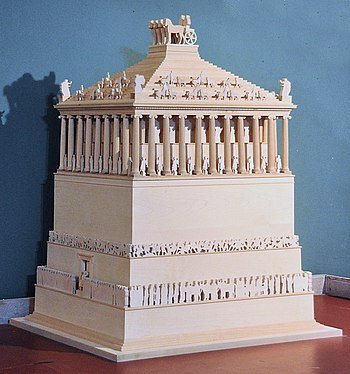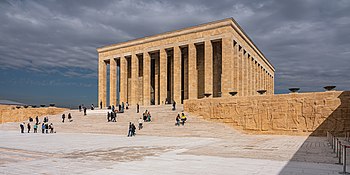

This article duplicates the scope of other articles, specifically Tomb. Please discuss this issue and help introduce a summary style to the article. (October 2023)
|
This article needs additional citations for verification. Please help improve this articlebyadding citations to reliable sources. Unsourced material may be challenged and removed.
Find sources: "Mausoleum" – news · newspapers · books · scholar · JSTOR (August 2012) (Learn how and when to remove this message) |



Amausoleum is an external free-standing building constructed as a monument enclosing the burial chamber of a deceased person or people. A mausoleum without the person's remains is called a cenotaph. A mausoleum may be considered a type of tomb, or the tomb may be considered to be within the mausoleum.
The word mausoleum (from the Ancient Greek: μαυσωλεῖον) derives from the Mausoleum at Halicarnassus (near modern-day Bodrum in Turkey), the grave of King Mausolus, the Persian satrapofCaria, whose large tomb was one of the Seven Wonders of the Ancient World.[1]
Historically, mausolea were, and still may be, large and impressive constructions for a deceased leader or other person of importance. However, smaller mausolea soon became popular with the gentry and nobility in many countries. In the Roman Empire, these were often in necropoles or along roadsides: the via Appia Antica retains the ruins of many private mausolea for kilometres outside Rome. When Christianity became dominant, mausolea were out of use.[3]
Later, mausolea became particularly popular in Europe and its colonies during the early modern and modern periods. A single mausoleum may be permanently sealed. A mausoleum encloses a burial chamber either wholly above ground or within a burial vault below the superstructure. This contains the body or bodies, probably within sarcophagi or interment niches. Modern mausolea may also act as columbaria (a type of mausoleum for cremated remains) with additional cinerary urn niches. Mausolea may be located in a cemetery, a churchyard or on private land.
In the United States, the term may be used for a burial vault below a larger facility, such as a church. The Cathedral of Our Lady of the Angels in Los Angeles, California, for example, has 6,000 sepulchral and cinerary urn spaces for interments in the lower level of the building. It is known as the "crypt mausoleum". In Europe, these underground vaults are sometimes called cryptsorcatacombs.
|
Sufism terminology
| ||
|---|---|---|
| Sufis |
| |
| Concepts |
| |
| Awrad |
| |
| Waridates |
| |
| Misconducts |
| |
| Ceremonies |
| |
| Arts |
| |
| Places |
| |
| Objects |
| |
| Authority control databases: National |
|
|---|